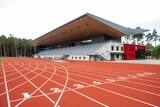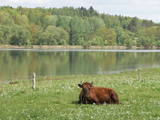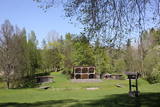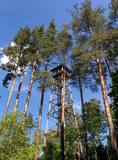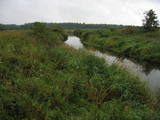| Nr | Name | Beschreibung |
|---|---|---|
|
Familienrestaurant in der Nähe der Freilichtbühne von Melluži in Jurmala, 27 km von Riga entfernt. Europäische und lettische Küche für alle Mahlzeiten, Tagessuppen, Salate, Hauptgerichte, eine Auswahl an Desserts und eine gemütliche Atmosphäre. |
||
|
Seit Herbst 2010 gibt es am Fluss Koiva (Grenzfluss zwischen Estland und Lettland) eine 60 km lange Fahrradroute, die Kulturerbeobjekte beider Staaten präsentiert. Die Route beginnt im Parkplatz am Berg Tellingumäe parklast, an den beiden Enden und am Grenzübergang sind Rastplätze und Karten. Wegweiser auf den Kreuzungen zur Navigation vorhanden, ausserdem sind die Sehenswürdigkeiten etwas abseits leicht zu finden. Beschreibungen bei den Objekten sind auf Estnisch, Lettisch und Englisch. Im Startpunkt beginnt auch eine andere 18 km lange Route. |
||
|
Ap 200 m garajā un izstieptās formas laukumā no 16. – 20. gs. atradās Liepājas tirgus. Laukuma malās tolaik bija izveidojusies vienstāvu apbūve – iebraucamās sētas, viesnīcas un dārzi. Līdz ar Pētertirgus izveidi 1910. gadā, izmainījās arī laukuma apveidi un to ieskaujošā apbūve. Laukuma DA malā slejas iespaidīgā Liepājas Svētās Annas Luterāņu baznīca. |
||
|
The farmstead Riveni specializes in fruitgrowing and the products of reprocessing those – dried apples, apple juice. |
||
|
Saimniecībā, kura atrodas pašā Sēlijas novada centrā, aug un zied vairāk nekā 400 dažādu rožu šķirnes, kā arī siltumnīcās tiek audzēti dažādi dārzeņu un puķu stādi. Iegādei tiek piedāvāti dažādi viengadīgie augi, vairāki simti rožu stādi un ēdamaugu stādi siltumnīcai un dārzam. |
||
|
Ursprünglich wurde schon 1938 eröffnet, aber später mehrmals umgebaut. Neben dem Stadion ist ein Gedenkstein für Jānis Daliņš (1904 – 1978) errichtet, einen mehrfachen Weltrekordler im Gehen. 1932 hat J. Daliņš bei den Olympischen Spielen in Los Angeles den zweiten Platz im Gehen errungen. Auf dem Stadion fanden 1993 die ersten lettischen Olympische Weltspiele der Drei Sterne statt. Heutzutage ist das Jāņis-Daliņš-Stadion ein Stadion der Leichtathletik von nationaler Bedeutung, auf dem internationale Wettkämpfe stattfinden. Das Stadion ist also ein Platz für Sportbetreibung, das den Status eines für Jugendliche freundlichen Platzes erworben hat. |
||
|
Eine professionelle landwirtschaftliche Tour, auf der man Wirtschaften für Obstbau kennenlernen kann, die für das Klima in Lettland angemessene Sorten selektionieren, züchten und vermehren. Ein Tag zum Kennenlernen: Besichtigung von Riga (UNESCO Kulturerbe) – der Hauptstadt Lettlands, sowie der Besuch eines Geschäftes für gesunde Lebensmittel. Am ersten Tag fahren wir in die Region Kurzeme, wo wir eine Wirtschaft besuchen, die eine besondere Technologie entwickelt hat, die bei der Verarbeitung von Sanddornen alle Stoffe und Vitamine zu erhalten hilft, die diese Beeren enthalten. Besuch des Weinberges von Sabile, wo Weintrauben schon im 16. – 17. Jh. angebaut wurden. Heutzutage wachsen hier ungefähr 15 verschiedene Weintraubensorten, die dem lettischen Klima angepasst sind. Die nächste Sehenswürdigkeit ist das Landgut von Kukšas, wo man das Kulturmilieu der Landgüter im 18. – 19. Jh. kennenlernen kann. Rückkehr in Riga durch den Kurort Jūrmala. Abendessen in einem Wirtshaus im lettischen Stil. Am nächsten Morgen fahren wir in die Region Vidzeme und besuchen einen Ort, wo zum ersten Mal in Lettland ein ehemaliges Torfmoor bearbeitet und für den Anbau von großfrüchtigen Moosbeeren verwendet wurde. Diese Wirtschaft hat ihre eigenen Verarbeitungstechnologien ausgearbeitet, um getrocknete Beeren, Sirupe, Säfte und Tees herzustellen. Als nächste ist eine Wirtschaft, die als erste in Lettland angefangen hatte, amerikanische Heidelbeeren zu züchten. Führung und Verkostung. Am Ende des Tages: Besichtigung einer Wirtschaft, die Moosbeeren und Heidelbeeren züchtet. Diese Wirtschaft zeichnet sich durch erfolgreiche und gesunde Lebensmittel und dessen Marketing aus. Am Morgen des vierten Tages – Besichtigung der mittelalterlichen Burg von Cēsis. Diese Burg war die Residenz der Heermeister des Livländischen Ordens und eine der stärksten Befestigungen auf dem Gebiet der heutigen baltischen Länder. Besuch der landwirtschaftlichen Fachschule von Priekuļi und Treffen mit den Lehrkräften. Am Ende des Tages fahren wir zum Landgut Ungurmuiža, das eines der bekanntesten Beispiele für barocke, im 18. Jh. gebaute Landgüter aus Holz in Lettland ist. Das Herrenhaus (1732) ist das einzige Schloss aus Holz aus dem 18. Jh., das sich in Lettland erhalten hat. |
||
|
Der Naturpark im Tal der Daugava ist der einzige Ort zwischen den Kaskaden der Wasserkraftwerke, wo man noch die Chance hat, das Flusstal der Daugava und die Schluchten der Nebenflüsse so zu sehen, wie sie waren, bevor das Gebiet geflutet und die Kraftwerke gebaut wurden. Einen besonders schönen Blick hat man vom rechten Flussufer in der Nähe von Kirche und Burgberg von Aizkraukle. Wälder, Wiesen, Flussquellen und kleine Dolomitfelsen sind in dieser Region alles geschützte Biotope. Freizeitangebote gibt es auf dem Burgberg von Aizkraukle, die Schloßruinen von Aizkraukle sind nicht weit entfernt.
|
||
|
Auf diesem Gelände kann man hervorragende Denkmäler besichtigen, die im ganzen Baltikum bekannt sind und die eine Geschichte von fast 1000 Jahren schildern: Das Landgut von Turaida (ein typisches Landgut der Region Vidzeme), die evangelisch-lutherische Kirche von Turaida, die eine der ältesten Kirchen (1750) aus Holz in Lettland ist, der Hügel Dainu kalns (Volksliederberg), der dem 150. Jubiläum des Sammlers der lettischen Volkslieder Krišjānis Barons gewidmet ist, und die gemauerte Burg von Turaida. Hier kann man die Kultur der Liven dieser Region kennenlernen, die Geschichte in Bildungsprogrammen erkunden, sowie jährliche Veranstaltungen besuchen, die mit Folklore und Völkerkunde verbunden sind. |
||
|
Das Spa Hotel Lohja genießt eine wunderschöne Lage in der Nähe des Lohja-Sees, umgeben von friedlicher Natur. Hier können Sie ein Fahrrad und / oder Boot mieten, ins Fitnessstudio gehen, Minigolf spielen, schwimmen und vieles mehr. |
||
|
Der bäuerliche Betrieb stellt Joghurt, Quark, saure Sahne, Sahne und Käse aus der Milch der eigenen Kuhherde (70 Kühe) her. An jedem Freitag kann man die Erzeugnisse vor Ort im bäuerlichen Betrieb kaufen. |
||
|
Dieses Zentrum ist eine der wichtigsten Sehenswürdigkeiten des Naturparks, die auf einem hundertjährigen und der historischen Region Sēlija charakteristischen Einzelgehöft eingerichtet ist. Hier hat man die Möglichkeit, eine dem Naturpark gewidmete ständige Ausstellung zu besichtigen, Produkte der örtlichen Handwerker und Bauer zu kaufen, sowie den Biberdrüsen-Aufguss zu probieren! Nördlich und östlich von dem Informationszentrum befindet sich der Pferch der Insel Putnu sala (Vogelinsel, 250 ha), wo für das Leben in der freien Natur angepasste Haustiere – Pferde der Rasse Konik und Hochlandrinder – weiden. Ungefähr 0,5 km von dem Ufer des Sees Skuķu ezers ist ein Vogelbeobachtungsturm aufgebaut. |
||
|
(In Silmači spielt ein beliebtes Theaterstück des lettischen Dichters Rudolfs Blaumanis, das allerjährlich zur Sommersonnenwende vielerorts aufgeführt wird: Schneidertage in Silmači („Skroderdienas Silmačos”). Nach Silmači muss man durch den Pērļu sils (Perlen- Kiefernwäldchen) und wenig bewohnte Orte fahren. In Silmači war in den 80er Jahren eine Freilichtbühne eigens für die Aufführung diese Stückes gebaut worden, die das Lettische Nationaltheater zur Sommersonnenwende (Ligo-Fest) 1986 am Originalschauplatz spielte. Zu diesem Anlass wurde auch neben der Bühne ein Museum eingerichtet, dessen Exposition der Thematik gewidmet ist. Hier kann man unter anderem auch das Originalmanuskript des Stückes von 1902 sehen. |
||
|
Im Hauptgebäude des Kreismuseums (ganzjährig geöffnet) und in den Filialen (geöffnet in der Sommersaison) bekommen sie einen guten Überblick über die Geschichte der Insel Hiiumaa und der See, Geschichte der Landwirtschaft und Gutshöfe, zaristische Zeit und Estnische Republik, über die Geschichte der Dago-Kertelsche Tuchfabrik, über die Sowjetzeit, u.a. Im Langen Haus finden Workshops für Kulturerbe statt. |
||
|
Uzcelts apkaimes augstākajā vietā – Ančupānu meža kalnā, kuru vietējie dēvē par „Bāku”. No 26 m augstā torņa redzama ļoti plaša panorāma ar Rēzeknes pilsētas namiem, baznīcu torņiem un apkaimes mežu masīviem, kas mijas ar lauksaimniecībā izmantojamām zemēm. Blakus tornim – atpūtas vieta. |
||
|
Die jahrhunderte alte Poststrasse führt zu Varbuse, wo sich die einzig intakten Poststation (1863) in Estland befindet. Früher gab es hier einen Pferdepoststation, heute ist hier das Estnische Strassenmuseum. Wenn Sie in den einzigartigen Expositsionsraum eintreten, können Sie die Verkehrsschilder sehen, die man auf den heutigen Straßen nicht mehr findet. Die Querschnitte der Straßenbeläge ermöglichen einen Blick in die Geheimnisse des Straßenbaus. Im historischen Straßenraum sind Strassenabschnitte dargestellt, so dass man den Hauch unterschiedlicher Zeitalter erleben kan. |
||
|
Die Umgebung von Tērvete ist bekannt für ihre Burghügel, die Märchenfiguren der lettischen Schriftstellerin Anna Brigadere, deren Skulpturen im Park zu finden sind, seinen alten Nadelwald, das Dendrarium, das historische Museum von Tērvete, den Aussichtsturm, die Landschaft uvm.
|
||
|
Talsu vecpilsētā, pašā vēsturiskā centra vidū, atrodas īpaša vieta, kur saplūst lauku miers un pilsētas dzīvīgums. Te vari izbaudīt gan klusumu un nesteidzīgu atmosfēru, gan arī sajust tuvumā esošo ielu dzīves ritmu. Šī māja ir kā radīta romantiskam nedēļas nogales atpūtam divatā — vakarā iekurt kamīnu, iemirdzināt telpu sveču gaismā un baudīt siltu vīna glāzi klusā divvientulībā. Tajā pašā laikā tā lieliski piemērota arī ģimenēm vai draugu kompānijām, kas vēlas pavadīt laiku kopā ērtā un plašā vidē. Villā pieejamas piecas guļamistabas, divas vannas istabas, kvalitatīva gultas veļa un dvieļi, satelīttelevīzija plakanajā ekrānā, ērta ēdamzona, pilnībā aprīkota virtuve, kā arī terase ar skatu uz dārzu. Papildus ērtībām viesiem ir atpūtas zona un kamīns, kas lieliski papildina vietas mājīgumu. |
||
|
Palieņu pļavas starp Rūjienu un Rūjas ieteku Burtnieku ezerā, kurām raksturīga liela augu un putnu sugu daudzveidība. Tās robežojas ar bijušiem Rūjas zivju dīķiem, kas šobrīd aizaug ar mežu. Rūjas palienes var vērot gan braucot ar laivu pa Rūju, gan arī no ceļa, kas ved uz minētajiem dīķiem. Tur izvietots informācijas stends.
|
||
|
You will feel the beauty, power and energy of nature here, ensuring harmony with nature and a good sense of the energy of rocks, plants, Latvian plants and underground streams. Rocks here decorate the garden, which offers a good view of the sea and a cascade of waterfalls that are delightful in the spring and the fall. During the summer, it is a rock river. The site is one km to the north of the bus stop in Tūja and has 28 types of coniferous trees, 14 decorative shrubs, 13 kinds of rhododendrons, and winter plants. The interesting collection of stones may mean that there is an energy field, and the garden is quite esoteric. The rocky seashore of Vidzeme is nearby, and the garden has received many prizes from the Salacgrīva Administrative District and Latvia as such. |
||









